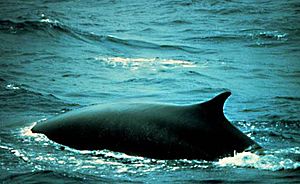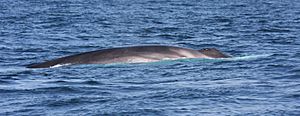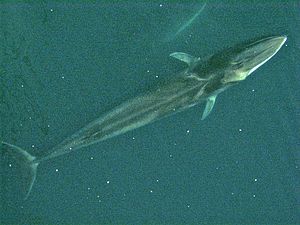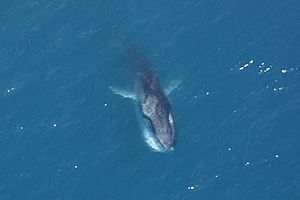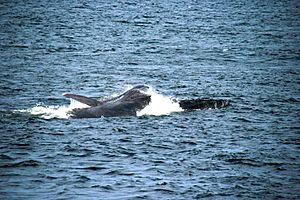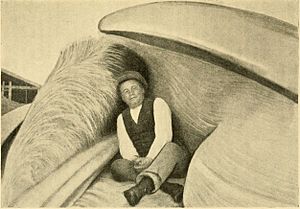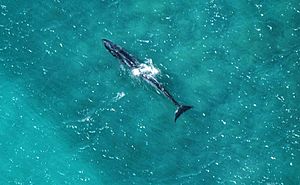Fin whale facts for kids
Quick facts for kids Fin whale |
|
|---|---|
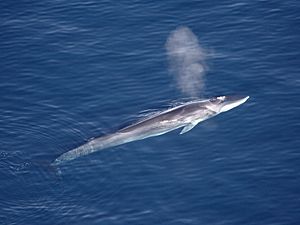 |
|
| A fin whale surfacing in Greenland | |
 |
|
| Size compared to an average human | |
| Conservation status | |
| Scientific classification | |
| Genus: |
Balaenoptera
|
| Species: |
physalus
|
| Subspecies | |
|
|
 |
|
| Fin whale range | |
| Synonyms | |
|
List
Balaena physalus Linnaeus, 1758 Balaena boops Linnaeus, 1758 Balaena antiquorum Fischer, 1829 Balaena quoyi Fischer, 1829 Balaena musculus Companyo, 1830 Balaenoptera rorqual Lacépède, 1804 Balaenoptera gibbar Lacépède, 1804 Balaenoptera mediterraneensis Lesson, 1828 Balaenoptera jubartes Dewhurst, 1834 Balaenoptera australis Gray, 1846 Balaenoptera patachonicus Burmeister, 1865 Balaenoptera velifera Cope, 1869 Physalis vulgaris Fleming, 1828 Rorqualus musculus F. Cuvier, 1836 Pterobalaena communis Van Beneden, 1857 |
|
The fin whale (Balaenoptera physalus) is a huge baleen whale. It is the second largest animal on Earth (the blue whale is the biggest). This whale is sometimes called the "greyhound of the sea" because of its fast swimming speed; it can swim up to 23 mph (37 km/hr) in short bursts. The fin whale is also called the finback, finner, razorback, common rorqual, and herring whale.
The fin whale's body is long and slender, coloured brownish-grey with a paler underside. The fin whale is a large baleen whale that belongs to the Cetacean order, which includes all species of whale, dolphin and porpoise. At least two recognized subspecies exist, in the North Atlantic and the Southern Hemisphere. It is found in all the major oceans, from polar to tropical waters. It is absent only from waters close to the ice pack at the poles and relatively small areas of water away from the open ocean. The highest population density occurs in temperate and cool waters. Its food consists of small schooling fish, squid, and crustaceans including copepods and krill.
Like all other large whales, the fin whale was heavily hunted during the 20th century and is an endangered species. Over 725,000 fin whales were reportedly taken from the Southern Hemisphere between 1905 and 1976; as of 1997 only 38,000 survived. Recovery of the overall population size of southern species is predicted to be at less than 50% of its pre-whaling state by 2100 due to heavier impacts of whaling and slower recovery rates.
The International Whaling Commission (IWC) issued a moratorium on commercial hunting of this whale, although Iceland and Costa Rica have resumed hunting. The species is also hunted by Greenlanders under the IWC's Aboriginal Subsistence Whaling provisions. Global population estimates range from less than 100,000 to roughly 119,000.
Contents
Anatomy
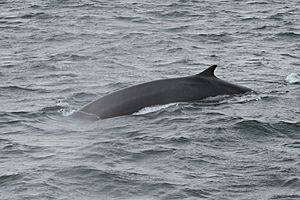
Size
In the Northern Hemisphere, the average size of adult males and females is about 18.5 and 20 metres (61 and 66 ft), respectively, averaging 38.5 and 50.5 tonnes (42.5 and 55.5 tons), while in the Southern Hemisphere, it is 20.5 and 22 m (67 and 72 ft), weighing 52.5 and 63 tonnes (58 and 69.5 tons).
In the North Atlantic, the longest reported were a 24.4 m (80 ft) male caught off Shetland in 1905 and a 25 m (82 ft) female caught off Scotland sometime between 1908 and 1914, while the longest reliably measured were three 20.7 m (68 ft) males caught off Iceland in 1973–74 and a 22.5 m (74 ft) female also caught off Iceland in 1975. Mediterranean population are generally smaller, reaching just above 20 m (65.5 ft) at maximum, or possibly up to 21–23 m (68.9–75.5 ft).
In the North Pacific, the longest reported were three 22.9 m (75 ft) males, two caught off California between 1919 and 1926 and the other caught off Alaska in 1925, and a 24.7 m (81 ft) female also caught off California, while the longest reliably measured were a 21 m (69 ft) male caught off British Columbia in 1959 and a 22.9 m (75 ft) female caught off central California between 1959 and 1970.
In the Southern Hemisphere, the longest reported were a 25 m (82 ft) male and a 27.3 m (89.6 ft) female, while the longest measured by Mackintosh and Wheeler (1929) were a 22.65 m (74.3 ft) male and a 24.53 m (80.5 ft) female. Major F. A. Spencer, while whaling inspector of the factory ship Southern Princess (1936–38), confirmed the length of a 25.9 m (85 ft) female caught in the Antarctic, south of the Indian Ocean; scientist David Edward Gaskin also measured a 25.9 m female as whaling inspector of the British factory ship Southern Venturer in the Southern Ocean in the 1961–62 season. Terence Wise, who worked as a winch operator aboard the British factory ship Balaena, claimed that "the biggest fin [he] ever saw" was a 25.6 m (84 ft) specimen caught near Bouvet Island in January 1958. The largest fin whale ever weighed (piecemeal) was a 22.7 m (74 ft) pregnant female caught by Japanese whalers in the Antarctic in 1948 which weighed 69.5 tonnes (68.4 long tons), not including 6% for loss of fluids during the flensing process. An individual at the maximum confirmed size of 25.9 m is estimated to weigh around 95 tonnes (104.5 tons), varying from about 76 tonnes (84 tons) to 114 tonnes (125.5 tons) depending on fat condition which varies by about 50% during the year.
A newborn fin whale measures about 6.0–6.5 m (19.7–21.3 ft) in length and weighs about 1,800 kilograms (4,000 lb).
Colouration and markings
The fin whale is brownish to dark or light gray dorsally and white ventrally. The left side of the head is dark gray, while the right side exhibits a complex pattern of contrasting light and dark markings. On the right lower jaw is a white or light gray "right mandible patch", which sometimes extends out as a light "blaze" laterally and dorsally unto the upper jaw and back to just behind the blowholes. Two narrow dark stripes originate from the eye and ear, the former widening into a large dark area on the shoulder—these are separated by a light area called the "interstripe wash". These markings are more prominent on individuals in the North Atlantic than in the North Pacific, where they can appear indistinct. The left side exhibits similar but much fainter markings. Dark, oval-shaped areas of pigment called "flipper shadows" extend below and posterior to the pectoral fins. This type of asymmetry is seen in Omura's whale and occasionally in minke whales. It was thought to have evolved because the whale swims on its right side when surface lunging and it sometimes circles to the right while at the surface above a prey patch. However, the whales just as often circle to the left. No accepted hypothesis explains the asymmetry. It has paired blowholes and a broad, flat, V-shaped rostrum. A light V-shaped marking, the chevron, begins behind the blowholes and extends back and then forward again.
The whale has a series of 56–100 pleats or grooves along the bottom of the body that run from the tip of the chin to the navel that allow the throat area to expand greatly during feeding. It has a curved, prominent dorsal fin that ranges in height from 26–75 cm (10–30 in) (usually 45–60 cm [18–24 in]) and averages about 51 cm (20 in), lying about three quarters of the way along the back. Its flippers are small and tapered and its tail is wide, pointed at the tip, and notched in the centre.
When the whale surfaces, the dorsal fin is visible soon after the spout. The spout is vertical and narrow and can reach heights of 6 m (20 ft) or more.
Nervous system
The oral cavity of the fin whale has a very stretchy or extensible nerve system which aids them in feeding.
Life history
Mating occurs in temperate, low-latitude seas during the winter, followed by an 11- to 12-month gestation period. A newborn weans from its mother at 6 or 7 months of age when it is 11 to 12 m (36 to 39 ft) in length, and the calf accompanies the mother to the summer feeding ground. Females reproduce every 2 or 3 years, with as many as six fetuses being reported, but single births are far more common. Females reach sexual maturity between 6 and 12 years of age at lengths of 17.7–19 m (58–62 ft) in the Northern Hemisphere and 20 m (66 ft) in the Southern Hemisphere. Calves remain with their mothers for about one year.
Full physical maturity is attained between 25 and 30 years. Fin whales have a maximum life span of at least 94 years of age, although specimens have been found aged at an estimated 135–140 years.
The fin whale is one of the fastest cetaceans and can sustain speeds between 37 km/h (23 mph) and 41 km/h (25 mph) and bursts up to 46 km/h (29 mph) have been recorded, earning the fin whale the nickname "the greyhound of the sea".
Fin whales are more gregarious than other rorquals, and often live in groups of 6–10, although feeding groups may reach up to 100 animals.
Vocalizations
Like other whales, males make long, loud, low-frequency sounds. The vocalizations of blue and fin whales are the lowest-frequency sounds made by any animal. Most sounds are frequency-modulated (FM) down-swept infrasonic pulses from 16 to 40 hertz frequency (the range of sounds that most humans can hear falls between 20 hertz and 20 kilohertz). Each sound lasts one to two seconds, and various sound combinations occur in patterned sequences lasting 7 to 15 minutes each. The whale then repeats the sequences in bouts lasting up to many days. The vocal sequences have source levels of up to 184–186 decibels relative to 1 micropascal at a reference distance of one metre and can be detected hundreds of miles from their source.
When fin whale sounds were first recorded by US biologists, they did not realize that these unusually loud, long, pure and regular sounds were being made by whales. They first investigated the possibilities that the sounds were due to equipment malfunction, geophysical phenomena, or even part of a Soviet Union scheme for detecting enemy submarines. Eventually, biologists demonstrated that the sounds were the vocalizations of fin whales.
Direct association of these vocalizations with the reproductive season for the species and that only males make the sounds point to these vocalizations as possible reproductive displays. Over the past 100 years, the dramatic increase in ocean noise from shipping and naval activity may have slowed the recovery of the fin whale population, by impeding communications between males and receptive females.
Fin whale songs can penetrate over 2,500 m (8,200 ft) below the sea floor and seismologists can use those song waves to assist in underwater surveys.
Breathing

When feeding, they blow 5–7 times in quick succession, but while traveling or resting will blow once every minute or two. On their terminal (last) dive they arch their back high out of the water, but rarely raise their flukes out of the water. They then dive to depths of up to 470 m (1,540 ft) when feeding or a few hundred feet when resting or traveling. The average feeding dive off California and Baja lasts 6 minutes, with a maximum of 17 minutes; when traveling or resting they usually dive for only a few minutes at a time.
Ecology
Range and habitat
Like many large rorquals, the fin whale is a cosmopolitan species. It is found in all the world's major oceans and in waters ranging from the polar to the tropical. It is absent only from waters close to the ice pack at both the north and south extremities and relatively small areas of water away from the large oceans, such as the Red Sea, although they can reach into the Baltic Sea, a marginal sea of such conditions. The highest population density occurs in temperate and cool waters. It is less densely populated in the warmest, equatorial regions.
The North Atlantic fin whale has an extensive distribution, occurring from the Gulf of Mexico and Mediterranean Sea, northward to Baffin Bay and Spitsbergen. In general, fin whales are more common north of approximately 30°N latitude, but considerable confusion arises about their occurrence south of 30°N latitude because of the difficulty in distinguishing fin whales from Bryde's whales. Extensive ship surveys have led researchers to conclude that the summer feeding range of fin whales in the western North Atlantic is mainly between 41°20'N and 51°00'N, from shore seaward to the 1,000 fathoms (1,800 m) contour.
Summer distribution of fin whales in the North Pacific is the immediate offshore waters from central Baja California to Japan and as far north as the Chukchi Sea bordering the Arctic Ocean. They occur in high densities in the northern Gulf of Alaska and southeastern Bering Sea between May and October, with some movement through the Aleutian passes into and out of the Bering Sea. Several whales tagged between November and January off southern California were killed in the summer off central California, Oregon, British Columbia, and in the Gulf of Alaska. Fin whales have been observed feeding 250 miles south of Hawaii in mid-May, and several winter sightings have been made there. Some researchers have suggested that the whales migrate into Hawaiian waters primarily in the autumn and winter.
Although fin whales are certainly migratory, moving seasonally in and out of high-latitude feeding areas, the overall migration pattern is not well understood. Acoustic readings from passive-listening hydrophone arrays indicate a southward migration of the North Atlantic fin whale occurs in the autumn from the Labrador-Newfoundland region, south past Bermuda, and into the West Indies. One or more populations of fin whales are thought to remain year-round in high latitudes, moving offshore, but not southward in late autumn. A study based on resightings of identified fin whales in Massachusetts Bay indicates that calves often learn migratory routes from their mothers and return to their mother's feeding area in subsequent years.
In the Pacific, migration patterns are poorly characterized. Although some fin whales are apparently present year-round in the Gulf of California, there is a significant increase in their numbers in the winter and spring. Southern fin whales migrate seasonally from relatively high-latitude Antarctic feeding grounds in the summer to low-latitude breeding and calving areas in the winter. The location of winter breeding areas is still unknown, since these whales tend to migrate in the open ocean.
Predation
The only known predator of the fin whale is the killer whale.
Feeding
The fin whale is a filter-feeder, feeding on small schooling fish, squid and crustaceans including copepods and krill. In the North Pacific, they feed on krill in the genera Euphausia, Thysanoessa, and Nyctiphanes, large copepods in the genus Neocalanus, small schooling fish (e.g. the genera Engraulis, Mallotus, Clupea, and Theragra), and squid. Based on stomach content analysis of over 19,500 fin whales caught by the Japanese whaling fleet in the North Pacific from 1952 to 1971, 64.1% contained only krill, 25.5% copepods, 5.0% fish, 3.4% krill and copepods and 1.7% squid. Nemoto (1959) analyzed the stomach contents of about 7500 fin whales caught in the northern North Pacific and Bering Sea from 1952 to 1958, found that they mainly preyed on euphausiids around the Aleutian Islands and in the Gulf of Alaska and schooling fish in the northern Bering Sea and off Kamchatka. In the northern Bering Sea (north of 58°N), their main prey species were capelin (Mallotus villosus), Alaska pollock (Theragra chalcogramma) and Pacific herring (Clupea pallasii); they also consumed saffron cod (Eleginus gracilis). Arctic krill (Thysanoessa raschii) was the only species of euphausiid found in the stomachs of fin whales in the northern Bering Sea. Off Kamchatka, they appeared to primarily feed on herring. They also took large quantities of the copepod Neocalanus cristatus around the Aleutian Islands and in Olyutor Bay off northeast Kamchatka, areas where the species was abundant. Five species of euphausiid (Euphausia pacifica, Thysanoessa spinifera, T. inermis, T. raschii, and T. longipes) were the predominant prey around the Aleutian Islands and in the Gulf of Alaska. Prey varied by region in the Kuril Islands area, with euphausiids (T. longipes, T. inermis, and T. raschii) and copepods (Neocalanus plumchrus and N. cristatus) being the main prey in the northern area and Japanese flying squid (Todarodes pacificus pacificus) and small schooling fish (e.g. Pacific saury, Cololabis saira; and Japanese anchovy, Engraulis japonicus) dominating the diet in the southern area.
Of the fin whale stomachs sampled off British Columbia between 1963 and 1967, euphausiids dominated the diet for four of the five years (82.3 to 100% of the diet), while copepods only formed a major portion of the diet in 1965 (35.7%). Miscellaneous fish, squid, and octopus played only a very minor part of the diet in two of the five years (3.6 to 4.8%). Fin whales caught off California between 1959 and 1970 fed on the pelagic euphausiid Euphausia pacifica (86% of sampled individuals), the more neritic euphausiid Thysanoessa spinifera (9%), and the northern anchovy (Engraulis mordax) (7%); only trace amounts (<0.5% each) were found of Pacific saury (C. saira) and juvenile rockfish (Sebastes jordani). In the Gulf of California, they have been observed feeding on swarms of the euphausiid Nyctiphanes simplex.
In the North Atlantic, they prey on euphausiids in the genera Meganyctiphanes, Thysanoessa and Nyctiphanes and small schooling fish (e.g. the genera Clupea, Mallotus, and Ammodytes). Of the 1,609 fin whale stomachs examined at the Hvalfjörður whaling station in southwestern Iceland from 1967 to 1989 (caught between June and September), 96% contained only krill, 2.5% krill and fish, 0.8% some fish remains, 0.7% capelin (M. villosus), and 0.1% sandeel (family Ammodytidae); a small proportion of (mainly juvenile) blue whiting (Micromesistius poutassou) were also found. Of the krill sampled between 1979 and 1989, the vast majority (over 99%) was northern krill (Meganyctiphanes norvegica); only one stomach contained Thysanoessa longicaudata. Off West Greenland, 75% of the fin whales caught between July and October had consumed krill (family Euphausiidae), 17% capelin (Mallotus) and 8% sand lance (Ammodytes sp.). Off eastern Newfoundland, they chiefly feed on capelin, but also take small quantities of euphausiids (mostly T. raschii and T. inermis). In the Ligurian-Corsican-Provençal Basin in the Mediterranean Sea they make dives as deep as 470 m (1,540 ft) to feed on the euphausiid Meganyctiphanes norvegica, while off the island of Lampedusa, between Tunisia and Sicily, they have been observed in mid-winter feeding on surface swarms of the small euphausiid Nyctiphanes couchi.
In the Southern Hemisphere, they feed almost exclusively on euphausiids (mainly the genera Euphausia and Thysanoessa), as well as taking small amounts of amphipods (e.g. Themisto gaudichaudii) and various species of fish. Of the more than 16,000 fin whales caught by the Japanese whaling fleet in the Southern Hemisphere between 1961 and 1965 that contained food in their stomachs, 99.4% fed on euphausiids, 0.5% on fish, and 0.1% on amphipods. In the Southern Ocean they mainly consume E. superba.
The animal feeds by opening its jaws while swimming at some 11 km/h (6.8 mph) in one study, which causes it to engulf up to 70 cubic metres (18,000 US gal; 15,000 imp gal) of water in one gulp. It then closes its jaws and pushes the water back out of its mouth through its baleen, which allows the water to leave while trapping the prey. An adult has between 262 and 473 baleen plates on each side of the mouth. Each plate is made of keratin that frays out into fine hairs on the ends inside the mouth near the tongue. Each plate can measure up to 76 cm (30 in) in length and 30 cm (12 in) in width.
The whale routinely dives to depths of more than 200 m (660 ft) where it executes an average of four "lunges", to accumulate krill. Each gulp provides the whale with approximately 10 kg (22 lb) of food. One whale can consume up to 1,800 kg (4,000 lb) of food a day, leading scientists to conclude that the whale spends about three hours a day feeding to meet its energy requirements, roughly the same as humans. If prey patches are not sufficiently dense, or are located too deep in the water, the whale has to spend a larger portion of its day searching for food. One hunting technique is to circle schools of fish at high speed, frightening the fish into a tight ball, then turning on its side before engulfing the massed prey.
Human interaction
Whaling
In the 19th century, the fin whale was occasionally hunted by open-boat whalers, but it was relatively safe, because it could easily outrun ships of the time and often sank when killed, making the pursuit a waste of time for whalers. However, the later introduction of steam-powered boats and harpoons that exploded on impact made it possible to kill and secure them along with blue and sei whales on an industrial scale. As other whale species became overhunted, the whaling industry turned to the still-abundant fin whale as a substitute. It was primarily hunted for its blubber, oil, and baleen. Around 704,000 fin whales were caught in Antarctic whaling operations alone between 1904 and 1975.
The fin whale was given full protection from commercial whaling by the IWC in the North Pacific in 1976, and in the North Atlantic in 1987, with small exceptions for aboriginal catches and catches for research purposes. All populations worldwide remain listed as endangered species by the US National Marine Fisheries Service and the International Conservation Union Red List. The fin whale is on Appendix 1 of CITES.
Museums
Several fin whale skeletons are exhibited in North America. The Natural History Museum of Los Angeles County in Los Angeles, California has an exhibit entitled the "Fin Whale Passage", which displays a 19.2 m (63 ft) fin whale skeleton collected by former museum osteologist Eugene Fischer and field collector Howard Hill in 1926 from the Trinidad whaling station (1920–1926) in Humboldt County, northern California. A steel armature supports the skeleton, which is accompanied by sculpted flukes. Science North, a science museum in Greater Sudbury, Ontario, Canada, has a 20 m (66 ft) fin whale skeleton collected from Anticosti Island hanging from the fourth floor of its main building. A 55 ft (17 m) skeleton hangs in the atrium (renovated in 2019–2020) of the science-mathematics building at Knox College (Illinois) in Galesburg, Illinois. Perhaps the largest fin whale skeleton exhibited is at The Grand Rapids Public Museum in Grand Rapids, Michigan, where a 76 ft (23.2 m) skeleton in the Galleria section hangs from the ceiling.
Several fin whale skeletons are also exhibited in Europe. The Natural History Museum of Slovenia in Ljubljana, Slovenia, houses a 13 m (43 ft) female fin whale skeleton—the specimen had been found floating in the Gulf of Piran in the spring of 2003. The Hungarian Natural History Museum in Budapest, Hungary, displays a fin whale skeleton hanging near its main entrance which had been caught in the Atlantic Ocean in 1896 and purchased from Vienna in 1900. The Cambridge University Museum of Zoology, in Cambridge, United Kingdom, exhibits a nearly 21 m (69 ft) male fin whale skeleton, which had stranded at Pevensey, East Sussex, in November 1865.
The Otago Museum, in Dunedin, New Zealand, displays a 16.76 m (55.0 ft) fin whale skeleton, which had stranded on the beach at Nelson at the entrance of the Waimea River in 1882.
A 20 m fin whale skeleton is exhibited at Van Thuy Tu Temple in Phan Thiết, Vietnam, where some local fishermen worship whales as near-divine beings who offer protection from storms.
Whale watching
Fin whales are regularly encountered on whale-watching excursions worldwide. In the Southern California Bight, fin whales are encountered year-round, with the best sightings between November and March. They can even be seen from land (for example, from Point Vicente, Palos Verdes, where they can be seen lunge feeding at the surface only a half mile to a few miles offshore). They are regularly sighted in the summer and fall in the Gulf of St. Lawrence, the Gulf of Maine, the Bay of Fundy, the Bay of Biscay, Strait of Gibraltar, the Mediterranean. In southern Ireland, they are seen inshore from June to February, with peak sightings in November and December.
Conservation
The fin whale is listed on both Appendix I and Appendix II of the Convention on the Conservation of Migratory Species of Wild Animals (CMS).
In addition, the fin whale is covered by the Agreement on the Conservation of Cetaceans in the Black Sea, Mediterranean Sea and Contiguous Atlantic Area (ACCOBAMS) and the Memorandum of Understanding for the Conservation of Cetaceans and Their Habitats in the Pacific Islands Region (Pacific Cetaceans MOU).
Images for kids
-
Drawing of a fin whale on a Faroese stamp, issued 17 September 2001
-
Fin whale and a boat in the Strait of Gibraltar
-
Finback Whale Skull, San Diego Natural History Museum
See also
 In Spanish: Balaenoptera physalus para niños
In Spanish: Balaenoptera physalus para niños






